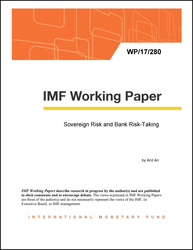
Sovereign Risk and Bank Risk-Taking
I propose a dynamic general equilibrium model in which strategic interactions between banks
and depositors may lead to endogenous bank fragility and slow recovery from crises. When
banks' investment decisions are not contractible, depositors form expectations about bank
risk-taking and demand a return on deposits according to their risk. This creates strategic
complementarities and possibly multiple equilibria: in response to an increase in funding
costs, banks may optimally choose to pursue risky portfolios that undermine their solvency
prospects. In a bad equilibrium, high funding costs hinder the accumulation of bank net
worth, leading to a persistent drop in investment and output. I bring the model to bear on the
European sovereign debt crisis, in the course of which under-capitalized banks in defaultrisky
countries experienced an increase in funding costs and raised their holdings of domestic
government debt. The model is quantified using Portuguese data and accounts for
macroeconomic dynamics in Portugal in 2010-2016. Policy interventions face a trade-off
between alleviating banks' funding conditions and strengthening risk-taking incentives.
Liquidity provision to banks may eliminate the good equilibrium when not targeted. Targeted
interventions have the capacity to eliminate adverse equilibria.
Publication date: December 2017
ISBN: 9781484333051
$18.00
Add to Cart by clicking price of the language and format you'd like to purchase
Available Languages and Formats
| English |
Prices in red indicate formats that are not yet available but are forthcoming.
Topics covered in this book
This title contains information about the following subjects.
Click on a subject if you would like to see other titles with the same subjects.
Risk-taking , Financial constraints , Sovereign debt crises , Financial Markets and the Macroeconomy , General , International Lending and Debt Problems , Government Policy and Regulation
Summary
Copyright © 2010 - 2024
Powered by:
AIDC



